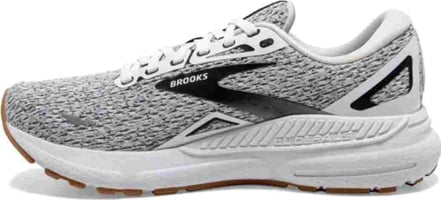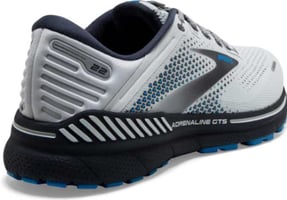Runners face a most important investment choice when upgrading their running shoes. Brooks...
Brooks Glycerin GTS 20 Review: Comparison to GTS 19 - Which is Best?

Shipping Worldwide
The Brooks Glycerin GTS 20 is a stability shoe designed for those needing extra support to manage extra or unwanted excessive movement while running or training. It’s the second version in this series that incorporates GuideRails support tech, keeping your stride in check.
It also uses cushioning in the midsole for extra support and comfort. That lets the shoe function as a street runner, but it works well for most training scenarios.
It offers a 10mm midsole drop, weighs just under 300g, and uses recycled materials in the upper to reduce the environmental impacts of its production process.
That means the shoe may feel heavy or lack some response. However, Brooks has created an excellent shoe with the Glycerin GTS 20 that adapts to your needs quickly and effectively.
Important Update: 5 Reasons to think twice about buying GTS 20
Pros and Cons
|
Pros |
Cons |
|
The midsole offers a mild level of cushioning that provides a softer feel instead of one with spring to it. |
Although the cushioning is excellent, there is enough softness in the product that causes it to lack responsiveness or feel clunky for some runners. |
|
Recycled materials are included in the upper, reflecting the brand’s commitment to use eco-friendly processes. |
It is an older model in the Glycerin series, so newer features could be available if investing in that upgrade. |
|
Its support technology works to limit excess movement and keep runners in their ideal stride, helping prevent injuries from improper positioning. |
Since this shoe feels a little heavy on the foot, the design could be concerning for those wanting a faster-paced or ultra-light product. |
|
The engineered air mesh upper and 3D-printed overlays offer a snug fit that’s breathable while maintaining a good lockdown. |
The posterior heel flare with a low-profile collar can make the back of your foot feel less stable, particularly when taking sharp turns. |
|
Runners receive a comfortable level of room to move with the expanded toebox without disrupting its fit security. |
The visual appeal of these shoes can be a bit underwhelming compared to other options from Brooks or competitors. |
How Brooks Glycerin GTS 20 Compares to the GTS 19s
When looking at the GTS 20 vs the GTS 19 and earlier models, you can see several different improvements available to runners in this release.
For starters, the midsole upgrade with the Glycerin GTS 20 delivers nitrogen-infused cushioning that feels much softer. It is designed to provide a comfortable ride while keeping the weight down as much as possible.
You don’t lose the responsiveness of the Glycerin design with this upgrade.
The 20s use a newly engineered air mesh upper for breathability and fit. The 3D-printed overlays are also improved to better lock the midfoot without applying excessive pressure to sensitive areas. It’s a snug fit that conforms instead of restricts, which is a definite positive.
There is still some clunkiness with the posterior flare with the 20s there is an update to the heel design that improves transitions with a runner’s gait compared to previous releases. That leads to more comfort and less irritation around the ankle and back of the foot.
Issues with navigating sharp corners or a fast turn that existed in previous versions are still present here with the 20s, even with the design updates.
What it is Like to Wear these Shoes
Overall, wearing these running shoes is a pleasant experience. The design checks all the boxes for those who want extra stability and cushioning with this essential training addition. These elements are included without sacrificing the product’s durability.
I do find the 20s to be heavier than a standard running shoe, which can lead to some fatigue around the ankle and the top of the foot. It doesn’t impact my training session unless it’s a long-distance run and I haven’t been using them for a few days.
The breathable upper is supportive with the 3D overlays. You get security, especially around the midfoot, without creating pressure points that lead to blisters or hot spots.
Although the toebox is wider than what you’ll find with other shoe designs, I’m not personally a fan of the tapering included in this release. It puts a bit of pressure to the outside portion of the foot that leads to discomfort during some runs. Even so, the frame does accommodate most runners to ensure stability.
The Brooks Glycerin GTS 20s do an excellent job for running on roads and paved surfaces. If you walk on uneven terrain, there can be some fit or stability issues. I like it more for casual wear, walking, or running within your current habits. It also works well for someone looking to establish new habits while keeping costs low.
How to Best Look After Your Glycerin GTS 20s
I have succeeded in surpassing over 800km with these shoes by treating them right and being conscious of how I run in them. Part of the reason why I feel I’ve been successful in prolonging their durability is that overpronation is not an issue for me. If anything, I tend to have underpronation concerns.
Since I’m not putting a lot of wear into the GuideRails, the support system can keep working its magic in providing a stable step within my stride.
There are some additional steps I have taken with the 20s to ensure they can continue joining me for training sessions in the future.
- I stick primarily to running on roads or paved trails. When you exercise on degraded or rural surfaces, the midsole and outsole tend to wear out faster than expected.
- The shoes are sensitive to dirt and debris. Dust can clog the upper and remove the breathability benefits. I wash them by hand with only mild soap and water.
- Do not place the shoes in direct sunlight, especially underneath a window. The heat can cause the foam and adhesives to degrade.
- It has helped to keep the shoes out of humid environments.
Finally, I look for abnormal wear patterns about twice per month to see how things are going when I feel good. If discomfort occurs after a run, I’ll check more regularly. Switching out the shoes for a different pair can sometimes help there as well.
Are these Shoes Worth Purchasing?
With dozens of different colourways to consider and various width options, it feels like you can get a custom shoe for the price of retail with the 20s. If you’re a runner who cannot get enough cushioning for your heel strikes or strides,
It is also a PDAC A5500 diabetic shoe. I found my pair to be true to size; however, it is often recommended for the 20s to look a possible half- or full-size up to ensure you receive a proper fit.
I love how the widened platform allows for a smoother stride. There are no worries about consistency with its structural build, while the breathability stays consistent when you give the shoes some regular love.
Although an argument could be made that they have too much cushioning, I believe the design blends firmness and comfort. If you’re looking for a similar experience, the Brooks Glycerin GTS 20 is an excellent option to consider.



